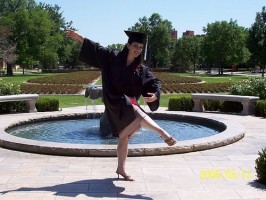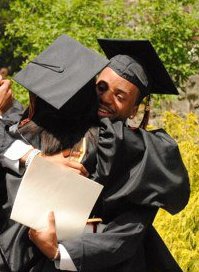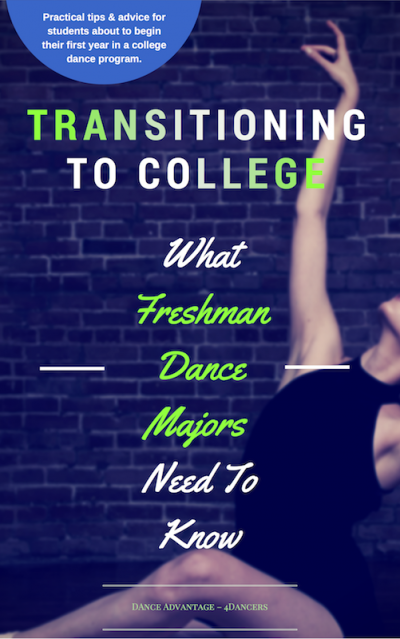For a dance educator there comes a point, usually in the fall, when it is time to start talking about certain “ends” with your dance students.

There is more to the college discussion than what kind of program best suits.
My goal is just to get kids on campus.
I use dance as a gateway to discuss college. Period.
Due to the structure, rigor, and creative nature of dance, dancers tend to be successful in many other aspects of education and life. Vicki Nelson lists the how and why in her article, 10 Credits Dancers Take With Them to College.
The arts produce creative thinkers, able to connect subjects, and develop pathways that standard students may not initially consider.
A major or a minor in dance can lead to a great number of career options that use dance education in important and innovative ways. If my dance students end up majoring and minoring in dance, great. If not, that is just as great. What I want for them are fulfilled lives with options, perspective, and jobs with health insurance. This doesn’t necessarily require a college degree, but in many instances, it does.
Especially for students who are the first generation in their families to attend college, studying the arts may seem to their parents a frivolous way to spend their hard-earned money.
Their families are concerned about the financial aspect, about being out-educated and thus judged by their children, or worry about their children leaving the nest and how their absence impacts the care for younger siblings. The idea of change is scary. Actual, change, however is necessary and usually more manageable than these families expect.
It is important that we give our students the information they need to approach these discussions with their families and provide concrete examples of what can be done with further education in Dance but also simply what further education can provide.
The Conversation Timeline
Kindergarten – Fourth grade
I begin talking about “what you want to be when you grow up” with my youngest students. I typically ask this question around September and again at the end of the year. It is interesting to see how their ideas change the more they learn, read, and write.
Fifth – Seventh grades
With upper elementary students, I ask what they want to be but also start talking about how to get there. We start talking about the role of higher education and what subjects may need to be a focus in order to make their dreams a reality.
Eighth – Ninth grades
Around middle school and early high school, I start getting specific and really push the grades. Emphasizing academic performance EARLY and its role in determining options is important. At this age, support and parent/teacher involvement are critical. If we haven’t done so already, we start identifying ways for them to get extra help in their challenging subjects.
If dance is a goal, we get serious about dance training. The content I provide in a K-12 classroom is often complimentary to core subjects while exposing students to as much of the field of dance as possible. I typically run after school classes for “serious” dancers and make connections with local dance organizations that are also capable of providing the technical support dancers need in order to be accepted into a college dance program.
Tenth – Eleventh grades
Junior year is usually the time to seriously explore the college dance option by visiting schools with virtual or actual school tours and getting to know the attributes of college dance programs within your state and beyond.
As an educator, I take great care in knowing which colleges offer majors, minors, certification in dance education, and classes for non-majors/minors. Knowing the general number and specialties of dance clubs on various campuses can be equally valuable.
It is important to know how the recreational dancer can be serviced on campus or in the community in case your student does not get accepted into their school of choice or decides not to major/minor in dance.
Once a student has reached campus
…make an effort to help them stay there.
It can be as simple as exchanging a few emails or answering the phone. The pressure of friends and family to come home, enter the family business, or quit in order to work full-time can be daunting and it won’t end just because they’ve managed to leave the nest. Sometimes your familiar voice will be all they need as a reminder to put their needs first.
The Fast and Dirty College Dance Degree Code:
- BFA: for students intending to pursue professional careers as dancers and choreographers. This tends to best prepare students for MFA study.
- BA: for students that may intent to perform/choreograph but may prefer to teach and/or double major in another academic subject. This path may lead to MA work in multiple disciplines.
- Dance Certification: for those intending to teach dance in the public schools. Without this distinction, you are NOT considered “Highly Qualified” to teach K-12 no matter what type of degree (including Masters!) you hold.
- Minor: for students that want to keep their options open, and readily apply their dance education to other subjects. Many dance minors begin as dancers that are not ready to “give it up yet.” Or a minor in dance is a compromise with their parents who think they should major in a more sensible area of study.
- Specialization: depending on the school, this may be equivalent to a minor or it may not.
A life in the arts is hard. These days, life is hard in any profession so why NOT dance?
Dance affects the body, the mind, and the spirit. Experience as a dancer enhances any career relating to these areas. This allows your student further distinction from other job candidates.
Of course, it also just pays to be really good at what you do.
Discipline and dedication are key components to dance training and translate into other fields of study and work ethic.
Versatility in thinking as well as being open and able identify new possibilities creates a form of job stability that no single profession seems able to provide.
Families want what is best for their children.
As educated professionals working in education, our reach must extend beyond the faces we see in our classrooms. We need to reach the families, too.
If your student indicates a desire to attend college, especially to study in the arts, offer to help them talk to their parents. Make information available and be willing to answer questions/concerns.
And please, be supportive if your student determines that returning home is what is best for them. Hopefully, they’ve made the choice for themselves.
Transitioning To College: What Freshman Dance Majors Need To Know is a college preparation guide for first-year students written specifically for dancers. It provides a snapshot of college life, essential information on what to expect in a dance program of study, and scores of tips and tricks for staying healthy and happy.
The E-book Helps You:
Own Your Education
What college freshman can expect to encounter freshman year in terms of dance technique and training, as well as overall scholastics.
Study Smarter, Not Harder
Manage Stress
Heather Vaughan-Southard MFA, is a choreographer, dance educator, and performer based in Michigan. She currently directs the dance program at the Everett High School Visual and Performing Arts Magnet in Lansing. With the philosophy of teaching dance as a liberal art, Ms. Vaughan-Southard collaborates with numerous arts and education organizations throughout the state. She has danced professionally in Chicago, Detroit, Los Angeles, and New York and has performed works by Mia Michaels, Lar Lubovitch, Donald McKayle, Billy Siegenfeld, Alexandra Beller, Debra Levasseur-Lottman, and Bob Fosse. As a choreographer, her work has been credited by the Los Angeles Times for “creating heat.” She has recently choreographed for the dance programs at Michigan State University, Grand Valley State University, Lansing Community College and is the former dance professor at Albion College. She is a regular guest artist and blogger for Dance in the Annex, an innovative dance community in Grand Rapids. Heather received her MFA in Dance from the University of Michigan, BFA in Dance from Western Michigan University and K-12 certification in Dance from Wayne State University. Read Heather’s posts.




